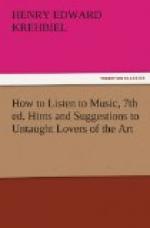[Sidenote: Technique of the Clavier players.]
[Sidenote: Change in technique.]
The transferrence of this music to the modern pianoforte has effected a vast change in the manner of its performance. In the period under consideration emotionality, which is considered the loftiest attribute of pianoforte playing to-day, was lacking, except in the case of such masters of the clavichord as the great Bach and his son, Carl Philipp Emanuel, who inherited his father’s preference for that instrument over the harpsichord and pianoforte. Tastefulness in the giving out of the melody, distinctness of enunciation, correctness of phrasing, nimbleness and lightness of finger, summed up practically all that there was in virtuosoship. Intellectuality and digital skill were the essential factors. Beauty of tone through which feeling and temperament speak now was the product of the maker of the instrument, except again in the case of the clavichord, in which it may have been largely the creation of the player. It is, therefore, not surprising that the first revolution in technique of which we hear was accomplished by Bach, who, the better to bring out the characteristics of his polyphonic style, made use of the thumb, till then considered almost a useless member of the hand in playing, and bent his fingers, so that their movements might be more unconstrained.
[Sidenote: Bach’s touch.]
[Sidenote: Handel’s playing.]
[Sidenote: Scarlatti’s style.]
Of the varieties of touch, which play such a role in pianoforte pedagogics to-day, nothing was known. Only on the clavichord was a blow delivered directly against the string, and, as has already been said, only on that instrument was the dynamic shading regulated by the touch. Practically, the same touch was used on the organ and the stringed instruments with key-board. When we find written praise of the old players it always goes to the fluency and lightness of their fingering. Handel was greatly esteemed as a harpsichord player, and seems to have invented a position of the hand like Bach’s, or to have copied it from that master. Forkel tells us the movement of Bach’s fingers was so slight as to be scarcely noticeable; the position of his hands remained unchanged throughout, and the rest of his body motionless. Speaking of Handel’s harpsichord playing, Burney says that his fingers “seemed to grow to the keys. They were so curved and compact when he played that no motion, and scarcely the fingers themselves, could be discovered.” Scarlatti’s significance lies chiefly in an extension of the technique of his time so as to give greater individuality to the instrument. He indulged freely in brilliant passages and figures which sometimes call for a crossing of the hands, also in leaps of over an octave, repetition of a note by different fingers, broken chords in contrary motion, and other devices which prefigure modern pianoforte music.




